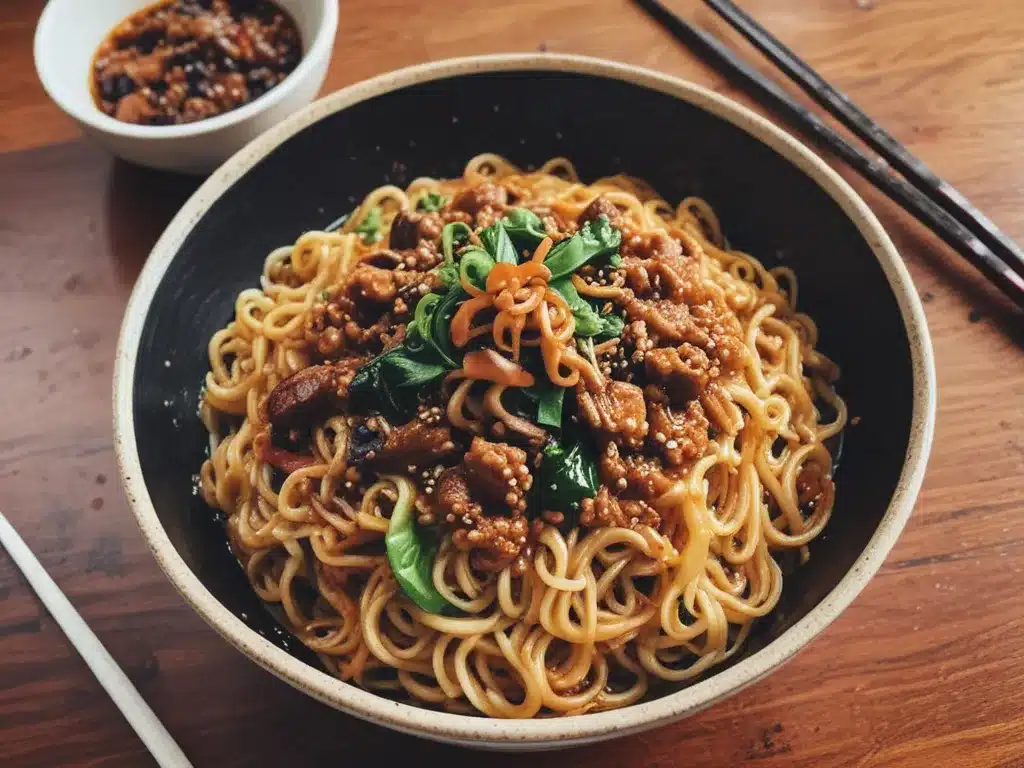
The Origins of Dan Dan Noodles
Dan dan noodles originated in Sichuan province, located in southwestern China. This comforting noodle dish evolved from street vendors pushing carts and selling their fare to hungry travelers and locals. The name “dan dan” comes from the sound of the wooden clappers that these vendors would noisily clap together to attract customers.
I have searched far and wide but have been unable to find the exact origin date of this beloved noodle dish. However, food historians speculate that dan dan noodles have been enjoyed in Sichuan for centuries, perhaps dating back to the Song Dynasty between the 10th-13th centuries AD. Thedefining spices and flavors of Sichuan cuisine were well established by this time.
Sichuan peppercorns play a key role in dan dan noodles. Along with chili oil or broad bean paste, these pungent berries are blended into the signature spicy and numbing sauce. Their unique flavor creates a sensation that is often described as tingly or buzzing. Through trade routes, this quintessential Szechuan ingredient eventually spread throughout China and beyond.
The Components of Dan Dan Noodles
No two versions of dan dan noodles are exactly alike, but there are several core components that define this dish:
Noodles
The noodles used can vary, but fresh Chinese wheat noodles or dried spaghetti are most common. The noodles should have a nice chew to stand up to the bold, spicy sauce.
Sauce
The addictive sauce is the heart and soul of dan dan noodles. It usually contains chili oil, Sichuan peppercorns, garlic, rice vinegar, sesame paste and soy sauce. Some cooks also add broad bean paste for extra savory depth.
Toppings
Typical toppings include sliced pork, preserved vegetables, scallions, cilantro and roasted peanuts. Each adds unique flavors and textures to round out the dish.
Serving Style
Dan dan noodles are often served in a bowl, with the hot noodles and sauce freshly combined at the table. This ensures the noodles do not become soggy. Diners mix everything together, slurping the noodles noisily to enjoy all the blended flavors with each bite.
Preparing Dan Dan Noodles at Home
While convenient packages of pre-made sauce are available, crafting homemade dan dan noodles from scratch truly allows one to appreciate the complexity of flavors in this iconic dish.
First, I heat up a wok or skillet with oil, then stir-fry aromatics like garlic and ginger to infuse their flavors. Next, I add pork or other proteins (chicken or tofu work well too) along with sliced vegetables for texture. Once lightly browned, I remove the stir-fry from the pan.
To make the star of the show – the sauce – I mash together Sichuan peppercorns, dried chilies, rice vinegar, soy sauce and other staple ingredients in a mortar and pestle or mini food processor until a paste forms. Thinning it out with water or oil achieves the perfect pouring consistency.
Finally, I cook the noodles until nearly al dente then toss everything together – hot noodles, sauce, meat and vegetables. Garnishing with peanuts, cilantro and a squeeze of lime or rice vinegar completes this satisfying meal. Enjoying it with friends makes the experience all the more enjoyable!
Regional Variations within China
While Sichuan dan dan noodles set the standard, other regions of China have put their own spin on this comfort food classic.
Taiwan Dan Dan Noodles
Taiwanese cooks tend to use thinner rice noodles in place of wheat noodles. Their sauce also incorporates kecap manis(Indonesian sweet soy sauce) for a subtle hint of molasses sweetness.
Guangdong Dan Dan Noodles
In southern China’s Guangdong province, ingredients like chili jam, fermented black beans and firm tofu amp up the savory and spice levels. Cooks there also top noodles with shrimp, squid or other seafood.
Shanghai Dan Dan Noodles
Shanghai dan dan noodles take on creamier, sweeter qualities from sauces based more on sesame paste than chili oil. Ground meatballs or minced chicken rather than slices also feature prominently.
No matter the regional variations, dan dan noodles continue satisfying Chinese and global food lovers with their tantalizing balance of heat, savory depth and slurp-worthy texture. They prove that sometimes, simplicity is the ultimate complexity.






